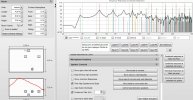jmf11
Member
Hello,
I'm starting to setup a 2.1 KH80+SVS SB-1000 system in my room. Unfortunatly, it's not a dedicated room, and so there are a lot of positionning constraints: MLP fixed by couch location, Subwoofer location fixed by WAF. But for more serious listening sessions, I can move the speakers (small and light) inside the room. I can EQ the speakers and the subwoofer, I have an UMIK microphone. So the idea is to find acceptable best (in contraint space) speakers location to reduce issues and then DSP.
I have read the Genelec and Neumann instructions for installation. Basically they say that in case of usage of a subwoofer, the main speakers should be away from the back wall of more than 1/4 the crossover frequency corresponding wavelength.
Today I played with REW room simulator, and discovered that in my room, the 100-300Hz range is quite sensitive to the position of the speakers. Very small changes in location create big dips. The left sepaker position also seem to be very sensitive.
Does it makes sense to work-out best/worse theoritical positions of the speakers based on REW room simulator? Other tools to identify good candidate positions or positions to really avoid ? Or are those simulators not accurate enough to process like that?
Advices welcomed to reduce trials and errors ;-)
Attached a screen shot. in red a crude representation of the ceiling slope (not possible to simulate in REW).
JMF
I'm starting to setup a 2.1 KH80+SVS SB-1000 system in my room. Unfortunatly, it's not a dedicated room, and so there are a lot of positionning constraints: MLP fixed by couch location, Subwoofer location fixed by WAF. But for more serious listening sessions, I can move the speakers (small and light) inside the room. I can EQ the speakers and the subwoofer, I have an UMIK microphone. So the idea is to find acceptable best (in contraint space) speakers location to reduce issues and then DSP.
I have read the Genelec and Neumann instructions for installation. Basically they say that in case of usage of a subwoofer, the main speakers should be away from the back wall of more than 1/4 the crossover frequency corresponding wavelength.
Today I played with REW room simulator, and discovered that in my room, the 100-300Hz range is quite sensitive to the position of the speakers. Very small changes in location create big dips. The left sepaker position also seem to be very sensitive.
Does it makes sense to work-out best/worse theoritical positions of the speakers based on REW room simulator? Other tools to identify good candidate positions or positions to really avoid ? Or are those simulators not accurate enough to process like that?
Advices welcomed to reduce trials and errors ;-)
Attached a screen shot. in red a crude representation of the ceiling slope (not possible to simulate in REW).
JMF

